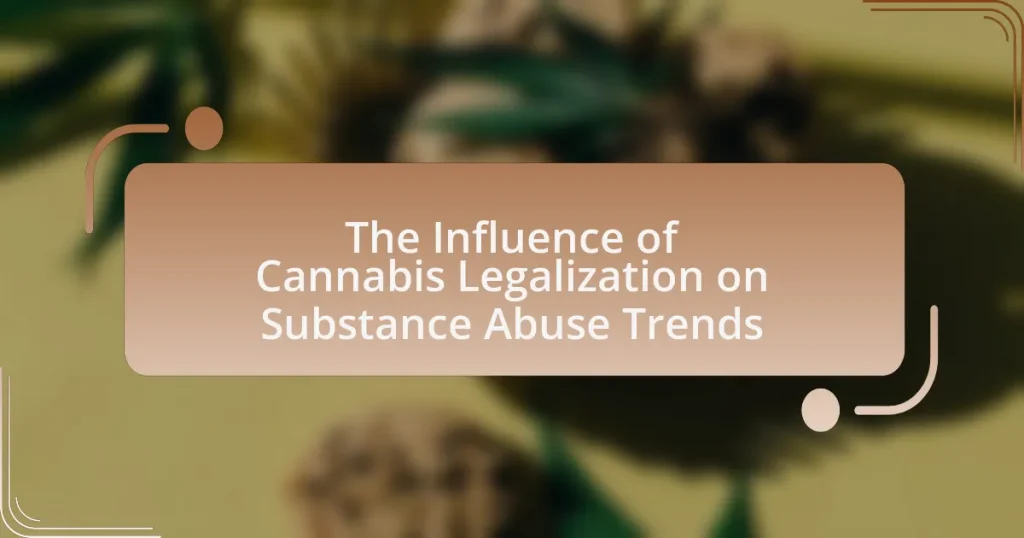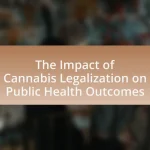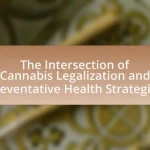The article examines the influence of cannabis legalization on substance abuse trends, highlighting its effects on the use of opioids and alcohol. Research indicates that states with legalized cannabis have seen a decrease in opioid prescriptions and related overdose deaths, with a 25% reduction reported in some studies. Additionally, alcohol consumption has declined in these regions, suggesting a substitution effect where individuals may prefer cannabis over alcohol. The article also explores demographic responses to legalization, public health implications, and the potential for future drug policy reforms, emphasizing the complex relationship between cannabis legalization and overall substance abuse patterns.
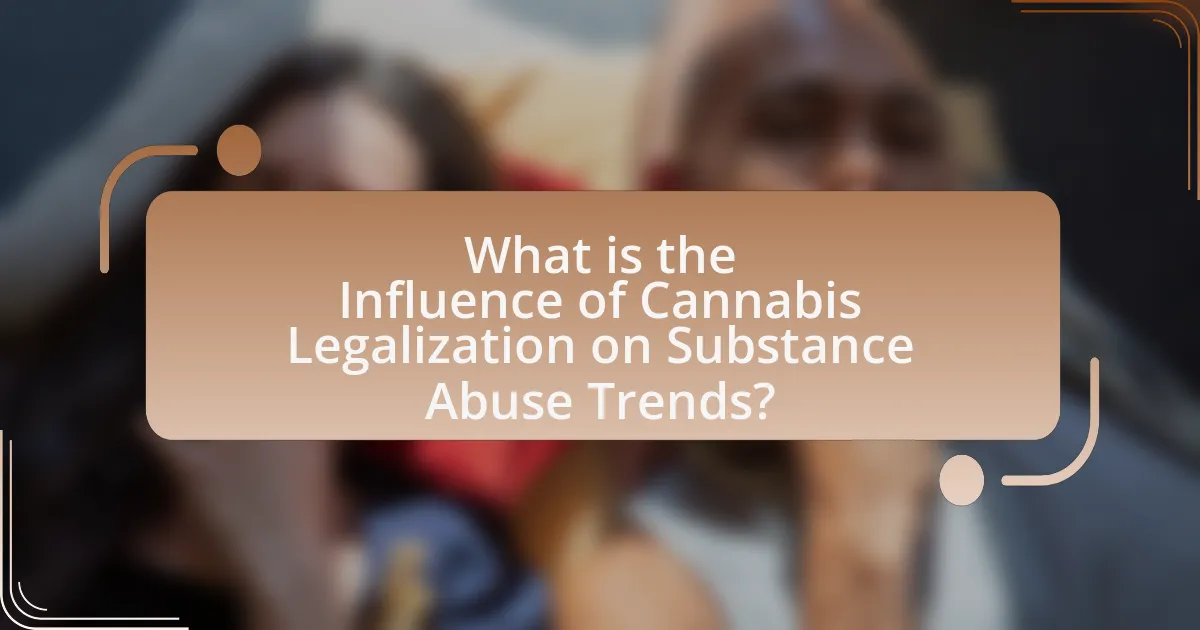
What is the Influence of Cannabis Legalization on Substance Abuse Trends?
Cannabis legalization generally leads to a decrease in the abuse of other substances, particularly opioids and alcohol. Research indicates that states with legalized cannabis have experienced a reduction in opioid prescriptions and related overdose deaths. For instance, a study published in the Journal of Health Economics found that states with medical cannabis laws saw a 25% reduction in opioid overdose deaths. Additionally, surveys show that alcohol consumption has declined in states where cannabis is legal, suggesting a substitution effect where individuals may choose cannabis over alcohol. These trends highlight the complex relationship between cannabis legalization and substance abuse patterns, indicating that legalization may not necessarily lead to increased overall substance abuse.
How has cannabis legalization changed the landscape of substance abuse?
Cannabis legalization has significantly altered the landscape of substance abuse by reducing the stigma associated with cannabis use and shifting patterns of substance consumption. Research indicates that in states where cannabis has been legalized, there has been a notable decrease in opioid prescriptions and related overdose deaths, suggesting a potential substitution effect where individuals may opt for cannabis over more harmful substances. For instance, a study published in the Journal of Health Economics found that states with legal cannabis saw a 25% reduction in opioid-related deaths. Additionally, surveys indicate that cannabis use has increased among adults, while alcohol consumption has shown mixed trends, with some reports indicating a decline in heavy drinking among certain demographics. These changes reflect a broader re-evaluation of substance use, where cannabis is increasingly viewed as a safer alternative to traditional illicit drugs and alcohol.
What are the key statistics related to substance abuse before and after legalization?
Key statistics indicate that substance abuse rates, particularly for cannabis, have changed significantly following legalization. For instance, a study published in the Journal of Health Economics found that cannabis use among adults increased by approximately 20% in states that legalized recreational use compared to those that did not. Conversely, the National Institute on Drug Abuse reported a decrease in opioid prescriptions by about 6% in states with legalized cannabis, suggesting a potential substitution effect. Additionally, data from the Substance Abuse and Mental Health Services Administration revealed that rates of cannabis use disorder increased from 1.5% to 2.5% among adults in legalized states, highlighting a rise in problematic use. These statistics illustrate the complex relationship between legalization and substance abuse trends.
How do different demographics respond to cannabis legalization in terms of substance use?
Different demographics respond to cannabis legalization with varying patterns of substance use, often influenced by age, gender, and socioeconomic status. For instance, studies indicate that younger adults, particularly those aged 18-25, tend to increase their cannabis use following legalization, with a 2019 study published in the Journal of Studies on Alcohol and Drugs showing a 20% rise in usage among this age group in states where cannabis was legalized. Conversely, older adults often exhibit more cautious behavior, with some studies suggesting a decrease in alcohol consumption as cannabis becomes more accessible. Gender differences also emerge, as males generally report higher rates of cannabis use compared to females, with a 2020 report from the Substance Abuse and Mental Health Services Administration indicating that 12.5% of males used cannabis in the past month compared to 6.5% of females. Socioeconomic factors further complicate these trends, as individuals from lower-income backgrounds may experience different impacts on substance use patterns compared to those from higher-income brackets.
Why is it important to study the influence of cannabis legalization?
Studying the influence of cannabis legalization is important because it provides insights into public health, economic impacts, and social justice issues. Research indicates that legalization can lead to changes in substance abuse patterns, as seen in states like Colorado, where cannabis use among adults increased by 20% post-legalization, while opioid-related deaths decreased by 6.5%. Understanding these trends helps policymakers make informed decisions regarding regulation, health education, and resource allocation. Additionally, examining the effects of legalization on marginalized communities can inform strategies to address historical injustices related to drug enforcement.
What are the potential societal impacts of cannabis legalization on substance abuse?
Cannabis legalization can lead to both increases and decreases in substance abuse rates, depending on various factors. Research indicates that in some regions, legalization has been associated with a decrease in opioid prescriptions and related overdoses, as individuals may substitute cannabis for more harmful substances. For instance, a study published in the Journal of Health Economics found that states with legalized medical cannabis experienced a 25% reduction in opioid overdose deaths. Conversely, other studies suggest that cannabis legalization may lead to increased use among certain demographics, particularly among adolescents, which could elevate the risk of developing substance use disorders. The National Institute on Drug Abuse reported that cannabis use among high school seniors increased from 21% in 2018 to 24% in 2020 in states where cannabis was legalized. Thus, the societal impacts of cannabis legalization on substance abuse are complex and multifaceted, reflecting both potential benefits and risks.
How does cannabis legalization relate to public health policies?
Cannabis legalization significantly impacts public health policies by necessitating the reevaluation of substance use frameworks and health interventions. Legalization leads to increased access and consumption, prompting public health officials to address potential health risks associated with cannabis use, such as mental health issues and substance abuse disorders. For instance, a study published in the American Journal of Public Health found that states with legalized cannabis experienced a 20% increase in cannabis-related emergency room visits, indicating a need for targeted health policies to manage these outcomes effectively. Additionally, public health policies may incorporate educational campaigns about responsible use and the risks of cannabis, reflecting the changing landscape of substance use in society.
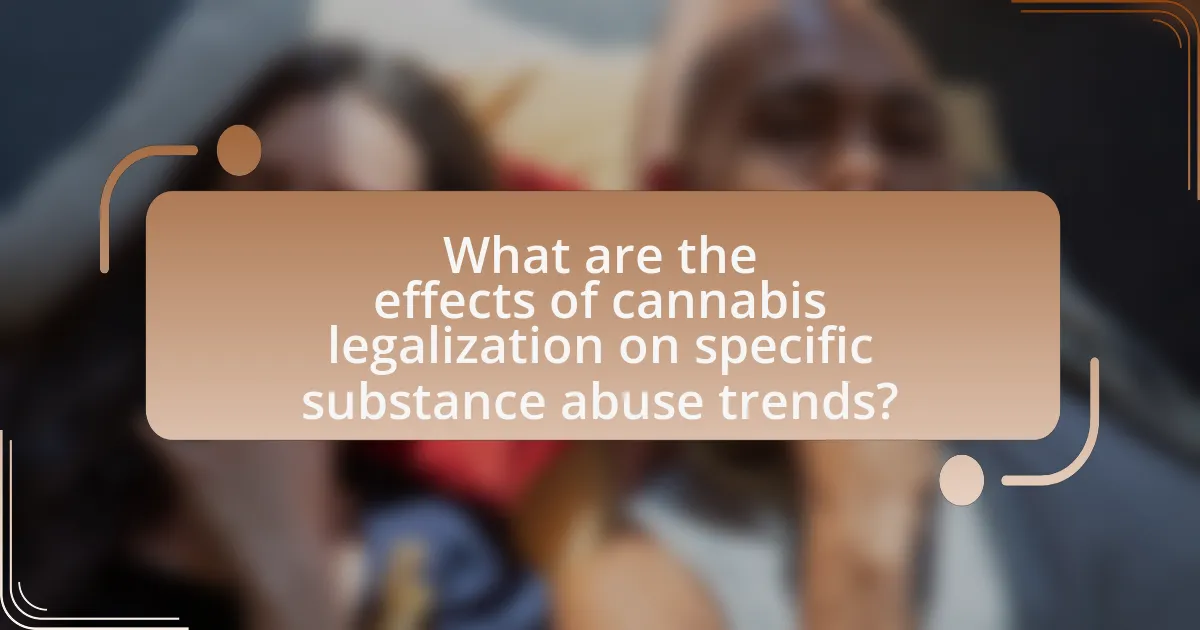
What are the effects of cannabis legalization on specific substance abuse trends?
Cannabis legalization has been associated with a decrease in the abuse of opioids and other illicit substances. Studies indicate that states with legalized cannabis have experienced a reduction in opioid prescriptions and related overdose deaths. For instance, a 2019 study published in the Journal of Health Economics found that states with medical cannabis laws saw a 6-8% reduction in opioid prescriptions. Additionally, research from the National Bureau of Economic Research in 2020 indicated that cannabis legalization correlates with lower rates of heroin use among young adults. These findings suggest that cannabis legalization may serve as a substitute for more harmful substances, thereby influencing overall substance abuse trends positively.
How does cannabis legalization affect alcohol consumption rates?
Cannabis legalization generally leads to a decrease in alcohol consumption rates. Studies indicate that in regions where cannabis has been legalized, there is often a corresponding decline in alcohol sales and consumption. For instance, a study published in the journal “Alcoholism: Clinical and Experimental Research” found that states with legalized recreational cannabis experienced a 15% reduction in alcohol sales. This trend suggests that individuals may substitute cannabis for alcohol, impacting overall drinking behaviors.
What evidence exists regarding changes in alcohol-related incidents post-legalization?
Evidence indicates that alcohol-related incidents have generally decreased in regions following cannabis legalization. For instance, a study published in the journal “Alcoholism: Clinical and Experimental Research” by Anderson et al. (2013) found that states with legalized recreational cannabis experienced a 15% reduction in alcohol sales. Additionally, research from the University of California, Berkeley, showed a decline in alcohol-related traffic fatalities in Colorado after legalization, suggesting a shift in substance use patterns. These findings support the notion that cannabis legalization may lead to reduced alcohol consumption and related incidents.
How do attitudes towards alcohol change with cannabis legalization?
Attitudes towards alcohol generally become more permissive with cannabis legalization. Research indicates that in regions where cannabis has been legalized, there is often a decrease in the perceived risks associated with alcohol consumption. For instance, a study published in the journal “Addiction” found that states with legalized recreational cannabis experienced a 15% increase in alcohol sales, suggesting that individuals may substitute cannabis for alcohol or feel more comfortable consuming alcohol in conjunction with cannabis. Additionally, surveys show that individuals in legalized areas report a more relaxed attitude towards both substances, reflecting a shift in social norms regarding alcohol use.
What is the relationship between cannabis legalization and opioid use?
Cannabis legalization is associated with a reduction in opioid use. Studies indicate that states with legalized cannabis have experienced lower rates of opioid prescriptions and opioid-related deaths. For instance, a 2019 study published in the Journal of the American Medical Association found that states with medical cannabis laws had a 25% lower rate of opioid overdose deaths compared to states without such laws. This suggests that cannabis may serve as an alternative for pain management, potentially decreasing reliance on opioids.
How has opioid prescription and abuse changed in states with legalized cannabis?
Opioid prescriptions and abuse have generally decreased in states that have legalized cannabis. Research indicates that states with legalized cannabis experience a significant reduction in opioid prescriptions, with studies showing a decrease of approximately 25% in opioid prescriptions within the first year of legalization. Additionally, data from the National Institute on Drug Abuse reveals that opioid overdose deaths have also declined in these states, suggesting a correlation between cannabis legalization and reduced opioid misuse. This trend highlights the potential of cannabis as an alternative pain management option, leading to lower reliance on opioids.
What role does cannabis play in opioid addiction treatment?
Cannabis may play a supportive role in opioid addiction treatment by potentially reducing withdrawal symptoms and cravings. Research indicates that cannabinoids can modulate pain and anxiety, which are common issues faced by individuals in recovery from opioid dependence. A study published in the Journal of Pain in 2015 found that cannabis use was associated with a significant reduction in opioid use among chronic pain patients, suggesting that cannabis could serve as an alternative or adjunct therapy. Additionally, a 2020 review in the journal Substance Abuse found that cannabis may help alleviate opioid withdrawal symptoms, further supporting its potential utility in addiction treatment.
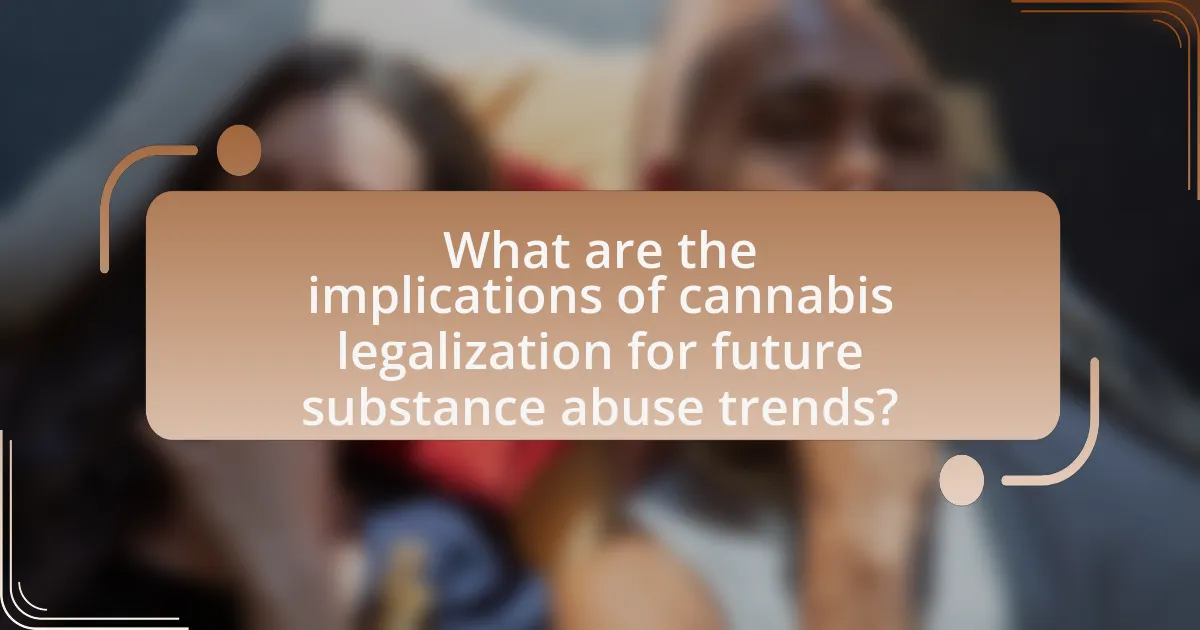
What are the implications of cannabis legalization for future substance abuse trends?
Cannabis legalization is likely to lead to a mixed impact on future substance abuse trends. Research indicates that while cannabis use may increase due to greater accessibility, the overall rates of abuse for other substances, such as opioids and alcohol, may decline. A study published in the journal “Health Affairs” found that states with legalized cannabis experienced a 25% reduction in opioid prescriptions, suggesting a potential substitution effect. Additionally, data from the National Institute on Drug Abuse shows that cannabis legalization does not correlate with increased rates of substance use disorders, indicating that legalization may not exacerbate substance abuse issues overall.
How might cannabis legalization influence future drug policy reforms?
Cannabis legalization may lead to significant reforms in future drug policies by shifting the focus from criminalization to regulation and public health. As seen in states like Colorado and Washington, legalization has prompted policymakers to reconsider the efficacy of punitive measures against drug use, leading to a more health-oriented approach that emphasizes harm reduction. Research indicates that in states where cannabis is legal, there has been a decrease in opioid prescriptions and related overdose deaths, suggesting that a regulated cannabis market can influence broader drug policy by prioritizing safety and education over punishment. This shift could encourage the reevaluation of laws surrounding other substances, potentially leading to decriminalization or legalization efforts for drugs like psilocybin and MDMA, as evidenced by recent legislative movements in various jurisdictions.
What lessons can be learned from states that have legalized cannabis?
States that have legalized cannabis demonstrate that legalization can lead to a reduction in opioid-related deaths and a decrease in overall substance abuse rates. For example, a study published in the American Journal of Public Health found that states with legal cannabis saw a 25% reduction in opioid overdose deaths compared to states without legalization. Additionally, data from the National Institute on Drug Abuse indicates that cannabis legalization does not correlate with increased use among adolescents, suggesting that legalization may not lead to higher rates of substance abuse in younger populations. These findings highlight the potential public health benefits of cannabis legalization, particularly in addressing the opioid crisis and managing substance use trends.
How can data from cannabis legalization inform prevention strategies for substance abuse?
Data from cannabis legalization can inform prevention strategies for substance abuse by providing insights into usage patterns, demographic shifts, and health outcomes. For instance, studies have shown that in states where cannabis has been legalized, there is often a decrease in opioid prescriptions and related overdose deaths, indicating a potential substitution effect. Research published in the Journal of Health Economics found that states with legalized cannabis experienced a 25% reduction in opioid-related deaths, suggesting that understanding these trends can help shape targeted prevention efforts. Additionally, data on youth cannabis use post-legalization can guide educational campaigns and interventions aimed at preventing substance abuse among adolescents, as evidenced by findings from the Monitoring the Future survey, which tracks substance use trends among youth.
What best practices can be adopted to mitigate substance abuse in the context of cannabis legalization?
To mitigate substance abuse in the context of cannabis legalization, implementing comprehensive education and prevention programs is essential. These programs should focus on informing the public about the risks associated with cannabis use, particularly among vulnerable populations such as youth. Research indicates that states with robust educational initiatives have seen lower rates of cannabis misuse. For instance, a study published in the Journal of Drug Issues found that states that invested in prevention education experienced a 20% decrease in cannabis-related emergency room visits among adolescents. Additionally, establishing strict regulations on advertising and sales, particularly targeting minors, can further reduce the likelihood of substance abuse. Evidence from Colorado’s regulatory framework shows that limiting marketing exposure to youth correlates with decreased consumption rates among this demographic.
How can education and awareness campaigns be structured to address substance abuse risks?
Education and awareness campaigns can be structured to address substance abuse risks by focusing on evidence-based information, targeted messaging, and community involvement. These campaigns should utilize data-driven approaches, such as statistics indicating that 21% of individuals who use cannabis may develop a substance use disorder, to highlight the potential risks associated with substance use. Additionally, campaigns should tailor their messages to specific demographics, ensuring that the content resonates with the audience’s experiences and concerns. Engaging community leaders and local organizations can enhance the campaign’s credibility and reach, fostering a supportive environment for discussions about substance abuse. Furthermore, incorporating interactive elements, such as workshops and social media engagement, can increase participation and retention of information, ultimately leading to more effective prevention strategies.
What role do community programs play in managing substance abuse trends post-legalization?
Community programs play a crucial role in managing substance abuse trends post-legalization by providing education, prevention, and support services tailored to the needs of individuals and families affected by substance use. These programs help mitigate potential increases in substance abuse by fostering awareness about the risks associated with legalized substances, such as cannabis, and promoting healthy coping mechanisms. For instance, studies have shown that community-based interventions can reduce substance use rates by up to 25% when they include comprehensive education and support systems. Additionally, community programs often facilitate access to treatment resources, which is essential in addressing substance use disorders effectively.
